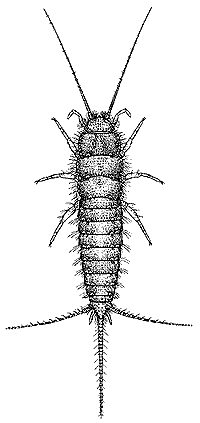|
Thysanura:
silverfish
Characteristics
These
fast running insects have become common inhabitants of manmade dwellings
and are often found in dark sheltered areas about the home. Silverfish
are usually less than 20 millimetres in length and silvery-grey
in colour. They appear similar to bristletails
(Archaeognatha) but can be distinguished by the following
features:

Acrotelsella devriesiana
|
|
- Soft, elongate
body tapering towards the abdomen
and covered with silvery-grey scales
- 3 long abdominal
cerci
of similar length with the outer 2 pointing away from the body
Acrotelsella
devriesiana belongs to the LEPISMATIDAE family of silverfish
which contains 5 cosmopolitan species that are household pests.
A.devriesiana though, is generally found in the southern
and central parts of Australia under bark, rocks and leaf litter.
Life Cycle
Most silverfish
reproduce sexually with the male depositing a sperm packet on the
substrate, which is picked up by the female. Depending on the species
the female may lay eggs only when she moults
or she may lay eggs singularly throughout her whole life. The young
develop over a series of moults
and may take up to 3 months to reach maturity. Silverfish will continue
to moult
throughout their lives and individuals may live for up to 4 years.
The nymphs
of silverfish resemble adults but are generally smaller in size.
Feeding
Most native
species of silverfish are nocturnal
herbivores
feeding on a variety of vegetable matter. The best-known domestic
species of silverfish that are common in most houses feed predominantly
on paper products and fabric found around the home. Some species
are omnivorous.
Habitat
Silverfish
occur in a wide variety of habitats both natural and manmade. Native
species are generally found living under the bark of trees, under
rocks, in rotten logs and among leaf litter. Some species have been
found to live exclusively in caves while others have been discovered
inhabiting the nests of ants and termites. Most species found in
homes are introduced and usually dwell in dark, rarely disturbed
places such as in cupboards and bookshelves.
|

